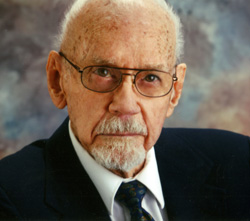
W. J. “Jack” Howard, a former Sandia National Laboratories executive vice president, was the third Sandian to be inducted into the laboratories’ Hall of Fame. Howard passed away Sept. 13 at the age of 88. Click on the thumbnail for a high-resolution image.
ALBUQUERQUE, N.M. — W.J. “Jack” Howard, a former Sandia National Laboratories executive vice president who was a valued national adviser on U.S. nuclear policy, passed away Sept. 13 at the age of 88.
During his career, Howard, who lived in Albuquerque, was responsible for the early recognition that U.S. nuclear weapons needed built-in controls to prevent unauthorized or inadvertent arming. He also participated in early nuclear weapons tests and was the first director of Sandia’s site in Livermore, Calif.
“Jack Howard’s contributions to Sandia and national security are immeasurable, from his nuclear weapons work to his advocacy of nuclear weapons safety to his leadership establishing Sandia’s California site. His actions over a 36-year career shaped the Laboratory into what it is today, and for that we are grateful,” Labs Director Paul Hommert said. “While we are saddened by this news, we will always remember Jack’s standards of excellence, his leadership and his national service.”
Shortly before his death, Howard became the third Sandia employee to be inducted into the laboratories’ Hall of Fame for his many contributions to Sandia. Howard attended a celebratory luncheon and ceremony at the Labs in June along with dozens of former colleagues, friends and family.
“Jack made tremendous contributions to U.S. national security during his years at Sandia. He was an extraordinary leader, dedicated to excellence and public service,” said Steve Rottler, Sandia vice president and chief technology officer who nominated Howard for the Hall of Fame. “With his family, we mourn Jack’s passing, but also celebrate his legacy and the lasting imprint he has left on our laboratory and the nation.”
Howard retired from Sandia in 1982 after serving nine years as executive vice president.
Prior to joining Sandia, Howard graduated with a degree in mechanical engineering from what is now New Mexico State University in Las Cruces and served in World War II. Howard survived a mountain airplane crash that killed the pilot by hiking for six days with a shattered kneecap until he found help.
In 1946, Howard joined the Z Division of Los Alamos National Laboratory, which is now Sandia.
Over the years, Howard acquired a long list of achievements in weapons work at Sandia. He directed the ordnance engineering design and development of the first Polaris missile warhead. And, he was the motivating force behind the concept of the nuclear warhead and delivery system, which led to what is known as the “Davy Crockett” infantry weapon system. The system was designed for use by the U.S. infantry against Soviet troops during the Cold War.
But safety and control of nuclear weapons also mattered to Howard. To prevent unauthorized detonation of nuclear weapons, Howard recognized early the need for built-in control of the arming sequence of U.S. nuclear weapons. He participated in preliminary design of the Permissive Action Link (PAL) system that resulted. The PAL system is a coded switch inside a nuclear weapon that blocks the arming signal and requires an order from the president to pass through the proper channels to the officer-in-charge, who then would enter the code.
Perhaps Howard’s most visible achievement to the public was Sandia’s California site. Howard was assigned in 1956 to inaugurate the new laboratory to provide ordnance engineering support to what is now known as Lawrence Livermore National Laboratory.
Howard also was recognized nationally for his nuclear weapons expertise. From 1963-1966, he served as assistant to the secretary of defense for atomic energy at the Department of Defense and was the chairman of the Atomic Energy Commission’s Military Liaison Committee. During this time, he assisted with ballistics support to locate a missing nuclear weapon near Palomares, Spain, after the collision of a B-52 and tanker aircraft during a refueling operation.
Former Defense Secretary Robert McNamara awarded Howard the Department of Defense Medal for Distinguished Public Service for his work.
Howard also served as a delegate to the Strategic Arms Limitation Talks in Geneva, Switzerland, in 1976.
Howard was the third inductee into Sandia’s Hall of Fame after former Vice President Glenn Fowler and Executive Vice President Robert Henderson.
Sandia National Laboratories is a multiprogram laboratory operated by Sandia Corporation, a wholly owned subsidiary of Lockheed Martin Corporation, for the U.S. Department of Energy’s National Nuclear Security Administration. With main facilities in Albuquerque, N.M., and Livermore, Calif., Sandia has major R&D responsibilities in national security, energy and environmental technologies, and economic competitiveness.
Sandia news media contact: Heather Clark, hclark@sandia.gov (505) 844-3511